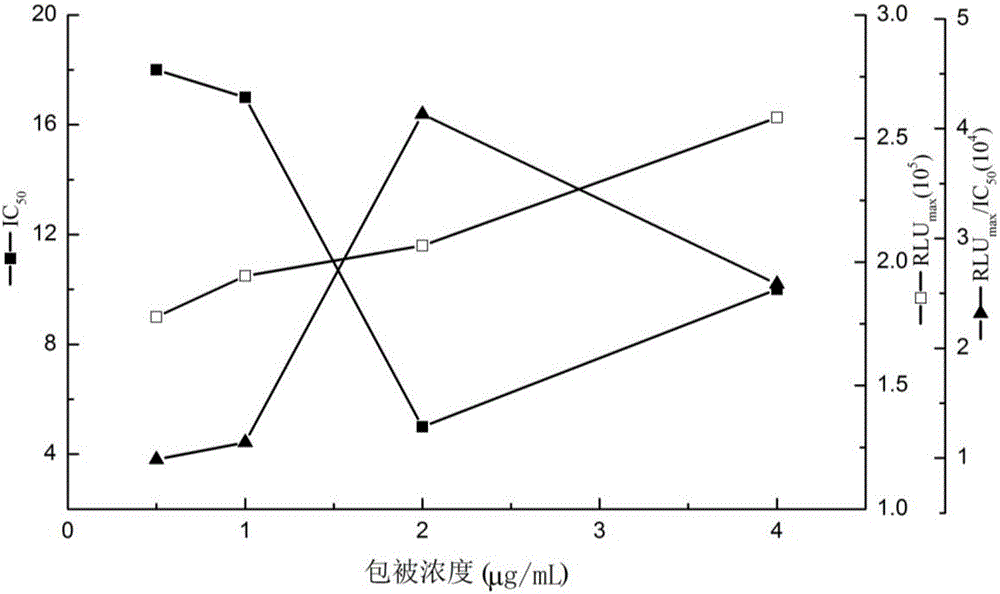Method for rapidly detecting alternaria tenuissima ketone acid
A technology of finely interleaved strobiluronic acid and strobiluronic acid, which is applied in the field of food testing, can solve the problems of being unsuitable for large-scale and rapid on-site testing, high quality requirements, and expensive equipment, and achieves continuous luminescence. The effect of long time, good specificity and high intensity of luminescent signal
- Summary
- Abstract
- Description
- Claims
- Application Information
AI Technical Summary
Problems solved by technology
Method used
Image
Examples
Embodiment 1
[0043] Polyclonal Antibody to Alternaria Acid
[0044] Take 6-8 week-old Balb / c female mice and immunize them by subcutaneous injection on the back of the neck. For the first immunization, TAO-KLH was mixed with an equal volume of Freund's complete adjuvant and completely emulsified; 21 days later, the booster was immunized with the above-mentioned TAO-KLH mixed with Freund's incomplete adjuvant; the booster was given every 2 weeks. Blood was collected from the orbit 7 days after the fifth immunization. The supernatant was collected by centrifugation, mixed with an equal volume of glycerol, and stored in a -20°C refrigerator.
[0045] Potency Determination of Polyclonal Antibody to Alternaria tenoneric Acid
[0046] At intervals of 7 days after immunization, blood was collected by docking the tail, and the serum titer was detected by indirect ELISA. by OD 450nm The dilution factor when the value is close to 1.0 is taken as the serum titer. Titer changes as figure 1 shown...
Embodiment 2
[0048] (1) Take the ELISA plate, add alternarione acid and BSA conjugate (TAO-BSA) diluted in carbonate buffer to each well, incubate at 4°C for 12 hours, and then wash the plate with PBST buffer Twice, pat dry, then add 5.0% skimmed milk powder to each well at 200 μL / well, block at 37°C for 60 min, wash the plate twice with PBST, and pat dry; obtain a TAO-BSA-coated ELISA plate with a coating concentration of 1.0 μg / mL, the coating amount is 100 μL / well; the concentration of the carbonate buffer is 0.05mol / L, and the pH is 9.6; the concentration of the PBST buffer is 0.01mol / L, and the pH is 7.4;
[0049] (2) Dilute the 1.0mg / mL alternaria tenoneric acid standard solution with PBS buffer solution to 7 concentrations of 0.018, 0.054, 0.164, 0.494, 1.481, 4.444, 13.333, 40ng / mL, and then Each 50 μL of the Alternaria tenoic acid standard solution of different concentrations was added to the standard well of the microplate in step (1), and then 50 μL of the preparation prepared i...
Embodiment 3
[0051] Influence of the pH value of PBS buffer on the detection results
[0052] Since the pH of the reaction system can directly affect the binding between the antigen and the antibody, thereby affecting the detection limit and sensitivity of the method, the pH of the diluted PBS buffer was adjusted to 5.8, 6.4, 7.4, and 8.0, and the remaining steps were performed according to Example 2. Experimental results such as figure 2 shown by figure 2 It can be seen that IC 50 As the pH increases, it first decreases slowly and then increases, and the RLU max Rise first and then fall, RLU max / IC 50 It is the highest when the pH is 7.4, so the pH of the PBS buffer is selected to be 7.4.
PUM
 Login to View More
Login to View More Abstract
Description
Claims
Application Information
 Login to View More
Login to View More - R&D
- Intellectual Property
- Life Sciences
- Materials
- Tech Scout
- Unparalleled Data Quality
- Higher Quality Content
- 60% Fewer Hallucinations
Browse by: Latest US Patents, China's latest patents, Technical Efficacy Thesaurus, Application Domain, Technology Topic, Popular Technical Reports.
© 2025 PatSnap. All rights reserved.Legal|Privacy policy|Modern Slavery Act Transparency Statement|Sitemap|About US| Contact US: help@patsnap.com



